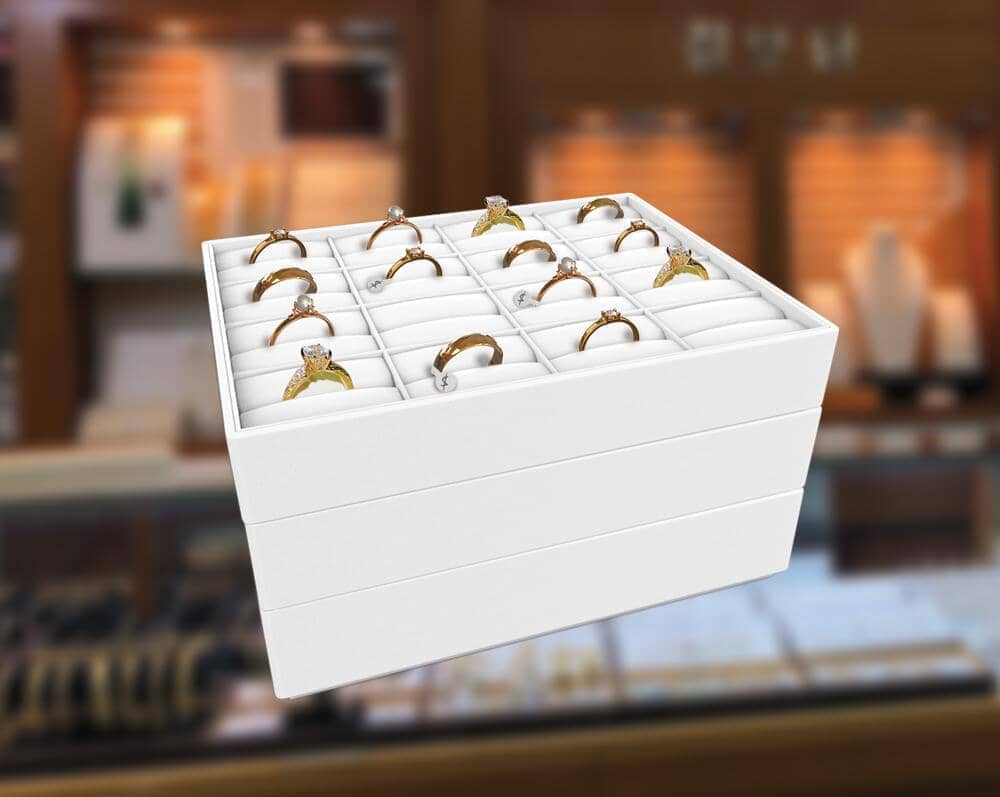
Guide to managing jewelry inventory: How to Stock and Track your Inventory
Jewelry is so small. Without the right method to track, it is not unlike guessing all the needles in a haystack.
What’s included in this post:
- What is jewelry inventory management?
- Why it’s important to set up a jewelry inventory management system
- 5 Tips to Tackle your Jewelry Inventory
- Place tags on everything
- Designate storage space for everything in your jewelry inventory
- Implement daily inventory tracking time
- Keep your old inventory visible
- Buy Less, More Frequently
What is jewelry inventory management?
Jewelry inventory management is the process of tracking every jewelry item from the purchase (or manufacture) point to the selling point. Jewelry inventory management is also the process by which you learn to predict buying patterns.
By having a jewelry inventory management system in place, you will be able to balance replenishing without overstocking. That, as any retailer can tell you, is a tricky balance.
Why it’s important to set up a jewelry inventory management system
Know what to reorder before you run out
Save on inventory costs
Less Dead Inventory
Greater cash flow
What is included in jewelry inventory?
Short answer? Everything. Even the things you don’t think of as jewelry.
Your jewelry inventory includes:
- All your jewelry findings and components.
- All your ready-to-sell jewelry pieces
- All your sample jewelry pieces (handmade or bought)
- All your jewelry store supplies (think: zip lock bags, jewelry tags, repair envelopes, etc.)
- All your jewelry packaging products
5 Tips to Tackle your Jewelry Inventory
1. Place tags on everything
As you might know, it’s important to label every piece of jewelry. You can do this by assigning a barcode or a SKU number that will help you keep track of your jewelry inventory.
SKU numbers don’t have to be meaningless. Many jewelers have different ways of cataloging their jewelry inventory, such as starting with the letter B for bracelets, N for necklaces, R for rings, etc.
Allurepack has jewelry tags that are easy to attach to jewelry pieces. Don’t use them just for the price! Write the SKU on them too.
Next, make sure to record the SKU/barcode along with a description of the item in your jewelry inventory pad, jewelry inventory spreadsheet, or the software you use for tracking your jewelry inventory.
2. Designate storage space for everything in your jewelry inventory
Every jewelry item should have a designated place in your jewelry store.
If there isn’t room in the showcase, keep them in stackable jewelry trays so that you have easy access when you need it.
Make use of jewelry ziplock bags! Use them for all your jewelry findings and components. Keep jump rings in one, clasps in another, etc. Don’t forget to label the bag with the count or weight!
3. Implement daily inventory tracking time
You should leave time in your daily schedule for a quick track-and-update. This is not a thorough audit!
If you maintain this daily tracking, you will be able to leave the physical counting for quarterly or even annual audits.
Here’s what you should do:
- Record all sales and update the inventory on your inventory pad or spreadsheet.
- If you have a POS system, then great, it’s all done for you. If it’s on a pad, take a highlighter and you can just highlight what was sold.
- Manually update the count of small components directly on labels that are on your small ziplock baggies, as well as on your spreadsheet, pad, or software
- You can keep updating the label with the count each time you remove one to save time counting and recounting.
- Alternatively, you can store them by weight. Know the amount for, say, ten grams. When you audit, weigh the bag with a jewelry scale and record the weight. When you refill, you’ll know how many to add to reach ten grams.
- Track your jewelry packaging supplies. Look at the items sold to know what jewelry boxes and jewelry gift bags you used, and update the count.
That’s it – you’re done for the day!
4. Keep your old inventory visible
It’s tempting to display only new pieces. Especially when you’re limited in showcase space and display fixtures.
But that puts your older pieces at risk of becoming dead inventory… And remember, jewelry has a “season” of only one year.
That means, if something is 4-5 months in your stock, you should be getting desperate to sell that old piece in your jewelry inventory.
Some steps to take:
- Refresh your display: Change the display piece on an old item or change the setup to give your things a fresh look.
- Place older jewelry inventory in front of your store, between newer items. Or keep some in a prime spot in your showcase. Just don’t relegate it to the back of your store.
- Once it’s past six months, it’s time for a discount, even if it hurts. Pretty soon it will be worth even loss, so recoup what you can get.
5. Buy Less, More Frequently
Less is more. And not just more greenbacks that stay in your pocket when you don’t invest in a hundred different styles.
High-end retailers all have a select few items for sale. Yet even if you’re not an exclusive boutique, you can still cash in by offering less.
Faced with too many choices, consumers were found less likely to purchase. (This was studied by professors in a popular study known as the Jam Study.)
With a curated collection, customers are not overwhelmed with “choice overload”. Therefore, they are more likely to purchase what they see.
So, limit your jewelry inventory to core styles that sell! Use your data from your updated inventory records to help with what to buy.
Of course, you should also do your due diligence on market research for new styles. But make the decision in place of re-purchasing something else.
In short, buy in small quantities and replenish as often as necessary. This will allow you to keep your jewelry inventory fresh and updated, buying as you need, to meet the demands of the consumer.
Conclusion
I hope this guide has given you ideas for jewelry inventory management.
As with everything, finding the sweet spot takes trial and error...
And once you set up a jewelry inventory system for tracking and buying stock, you’ve just got to tweak it to meet your needs.



